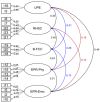The Intuitive Eating Scale-2 Adapted for Mexican Pregnant Women: Psychometric Properties and Influence of Sociodemographic Variables
- PMID: 38004230
- PMCID: PMC10675059
- DOI: 10.3390/nu15224837
The Intuitive Eating Scale-2 Adapted for Mexican Pregnant Women: Psychometric Properties and Influence of Sociodemographic Variables
Abstract
A weight-inclusive approach to health involves the promotion of intuitive eating, i.e., the individual's ability to be aware of their physiological hunger and satiety cues to determine when and how much to eat, while paying attention to how certain foods affect their body. The second version of the Intuitive Eating Scale (IES-2) evaluates four interrelated traits of intuitive eating: Unconditional Permission to Eat (UPE), Eating for Physical rather than emotional Reasons (EPR), Reliance on internal Hunger/Satiety Cues (RHSC), and Body-Food Choice Congruence (BFCC). In this study, our aim was to evaluate the psychometric properties of a Mexican Spanish adaptation of the IES-2 for pregnant women and examine the relationship between intuitive eating traits and maternal sociodemographic characteristics. A sample of 514 pregnant women answered our IES-2 adaptation and a sociodemographic questionnaire. We determined the quality, validity, and reliability of our adaptation through descriptive measures, frequency distributions, intra-class correlations, and extreme answer group comparison for each item, eliminating those with weak technical properties. We then performed an exploratory principal component analysis and a confirmatory factor analysis. Last, we analyzed the association between intuitive eating and maternal sociodemographic and reproductive variables through correlation tests and multivariable linear regressions. Psychometric tests confirmed the validity and reliability of our IES-2 adaptation, which comprised 18 out of the 23 original items. Notably, both the exploratory and confirmatory factor analyses yielded not four but five factors, due to the EPR subscale splitting in two (the "emotional" and "physical" components of EPR). We attribute this novel finding to the emotional manifestations that naturally accompany pregnancy, which may incline pregnant women to base their eating behaviors more on the emotional than the physical component that would otherwise dominate their EPR trait. Further research is also needed about the UPE subscale during pregnancy, due to item removal and subtle changes in meaning. Finally, the influence of sociodemographic variables on the IES-2 score was extremely low, suggesting that other variables, possibly of a psychological nature, may have greater influence on a pregnant woman's intuitive eating.
Keywords: eating behaviors; intuitive eating; intuitive eating scale; pregnancy; psychometric properties; sociodemographic factors.
Conflict of interest statement
The authors declare no conflict of interest.
Figures

Similar articles
-
Validation of the intuitive Eating Scale for pregnant women.Appetite. 2017 May 1;112:201-209. doi: 10.1016/j.appet.2017.02.001. Epub 2017 Feb 3. Appetite. 2017. PMID: 28167151
-
Cross-cultural validity of the Intuitive Eating Scale-2. Psychometric evaluation in a sample of the general French population.Appetite. 2015 Jan;84:34-42. doi: 10.1016/j.appet.2014.09.009. Epub 2014 Sep 17. Appetite. 2015. PMID: 25239401
-
German version of the intuitive eating scale: Psychometric evaluation and application to an eating disordered population.Appetite. 2016 Oct 1;105:798-807. doi: 10.1016/j.appet.2016.07.019. Epub 2016 Jul 15. Appetite. 2016. PMID: 27426620
-
Psychometric properties of the Arabic version of the Intuitive Eating Scale-2 (IES-2) in a sample of community adults.J Eat Disord. 2023 Apr 1;11(1):53. doi: 10.1186/s40337-023-00782-3. J Eat Disord. 2023. PMID: 37005688 Free PMC article.
-
A Mexican Spanish Adaptation of the Dutch Eating Behavior Questionnaire: Psychometric Properties and Influence of Sociodemographic Variables in Pregnant Women.Nutrients. 2023 Jul 21;15(14):3243. doi: 10.3390/nu15143243. Nutrients. 2023. PMID: 37513659 Free PMC article.
Cited by
-
The Chinese Version of the Intuitive Eating Scale-2 Adapted for Pregnant Women: Psychometric Properties and Associations With Diet Quality.Brain Behav. 2025 Jun;15(6):e70568. doi: 10.1002/brb3.70568. Brain Behav. 2025. PMID: 40443215 Free PMC article.
References
-
- Tylka T.L., Annunziato R.A., Burgard D., Daníelsdóttir S., Shuman E., Davis C., Calogero R.M. The Weight-Inclusive versus Weight-Normative Approach to Health: Evaluating the Evidence for Prioritizing Well-Being over Weight Loss. J. Obes. 2014;2014:983495. doi: 10.1155/2014/983495. - DOI - PMC - PubMed
-
- National Research Council. Institute of Medicine. Board on Children, Youth, and Families. Food and Nutrition Board. Committee to Reexamine IOM Pregnancy Weight Guidelines . Weight Gain during Pregnancy: Reexamining the Guidelines. National Academies Press; Washington, DC, USA: 2010.
-
- International Weight Management in Pregnancy (i-WIP) Collaborative Group Effect of Diet and Physical Activity Based Interventions in Pregnancy on Gestational Weight Gain and Pregnancy Outcomes: Meta-Analysis of Individual Participant Data from Randomised Trials. BMJ. 2017;358:j3119. doi: 10.1136/bmj.j3119. - DOI - PMC - PubMed
-
- Tylka T.L. Development and Psychometric Evaluation of a Measure of Intuitive Eating. J. Couns. Psychol. 2006;53:226–240. doi: 10.1037/0022-0167.53.2.226. - DOI
MeSH terms
Grants and funding
LinkOut - more resources
Full Text Sources

